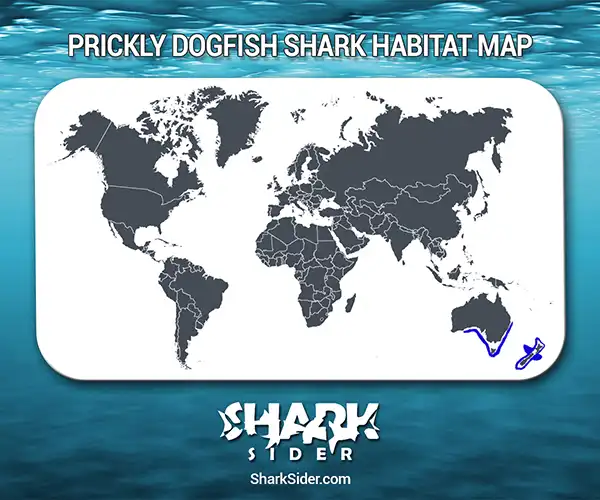The Prickly Dogfish (Oxynotus bruniensis) is a little known, deep-water shark that lives in the temperate waters off of Australia and New Zealand. It has also been referred to as the Rough Shark, Prickly Shark, or as “pepeke” by the Maori people of New Zealand.
This species is one of 5 members in the Oxynotus genus, which together comprise the family known as the Angular Rough Sharks (Oxynotidae). That makes it a close relative of another species featured here recently, the Sailfin Rough Shark. This family of sharks has a curious, chubby, almost cartoon-like appearance.
This brownish-gray Dogfish has a body that is humped and compressed. There is a distinct lateral keel on either side of the flat belly. Combined, these features make the cross-section of the body almost triangular. The two high, floppy and sail-like dorsal fins have raised, fleshy bases. A long, sharp spine is present in front of each dorsal fin, deeply embedded in the skin. The skin has a very rough, prickly feel like sandpaper, due to the presence of scales known as dermal denticles (this is the source of the fish’s common name). The maximum length of adults is 60 cm (23.6″) for males and 72 cm (28.3″) for females.
Prickly Dogfish Facts
The hump-backed shape is considered to be the most energy-efficient body type for fishes that live near the bottom of the ocean. (In contrast, a cigar-shaped body is most efficient for swimming in open water).
A couple of sources that we encountered in researching this article mentioned that members of Oxynotus have a luminous organ. Similarly, another source stated that some Dogfish Sharks have luminous eyes or secrete bioluminescent “mucus” to attract prey. It might be possible, then, that the Prickly Dogfish can generate bioluminescence. However, we could not find any explicit mention of this, despite a concerted search in the scientific literature. (Perhaps this is not surprising – because this fish lives in deep-water, little is known about its biology).
Habitat and Range
Map Of The Prickly Dogfish Shark’s Habitat

The Southwest Pacific is the home of this shark, which lives along the continental shelf and upper slopes of Australia and New Zealand.
The Prickly Dogfish is an example of species that are well adapted to conditions in the “Mesopelagic Zone” of the ocean, also known as the Twilight Zone. This is the next layer beneath the “sunlight zone” up at the surface. The Twilight Zone exists from about 200 to 1000 m (660 to 3300 ft) and receives little sunlight. Correspondingly, the Prickly Dogfish Shark has been found in waters up to 1067 m (3520 ft) deep, although it inhabits most commonly depths of 300 to 650 m (990 to 2150 ft).
Feeding Behavior
Similar to the dearth of information about the general biology of this species, little is known about its diet and feeding behavior. The mouth has thick fleshy lips, spear-shaped teeth in the upper jaw, and blade-like teeth in the lower jaw. This anatomy resembles the mouth of the Cookie Cutter Shark.
These Dogfish spend time lying flat on the sea floor, so their diet is thought to consist of benthic fish and invertebrates.
Social Behavior
These sharks are probably solitary, but no information was encountered.
Breeding
Prickly Dogfish have an ovoviviparous breeding system with a low rate of productivity. Females can carry 7 or 8 embryos at a time, divided between a right and a left uterus! Pups are about 24 cm (9.5″) long at birth.
Humans and Conservation
The Prickly Dogfish is a harmless shark, posing no threat to people (unless of course you were silly enough to grab onto one of those foreboding dorsal spines!).
The species is of no commercial interest to fisheries. It is sometimes caught accidentally with bottom trawls, but the extent of mortality from this activity is unknown.
The IUCN Red List assesses this species as “Data deficient”. Although it is widespread within its range, it is also uncommon and caught only occasionally. As such, no conservation measures currently exist for this species.
Written By: Kara Lefevre
Sources
ARKive
Carrier JC, Musick JA & Heithaus MR (editors) (2010). Sharks and Their Relatives II: Biodiversity, Adaptive Physiology, and Conservation. CRC Press.
FishBase, Oxynotus Bruniensis & Family Summary.
Francis MP (2003). Oxynotus bruniensis. In: IUCN 2012. IUCN Red List of Threatened Species. Version 2012.2.
Garrick JAF (1960). Studies on New Zealand Elasmobranchii. PartXI.-Squaloids of the genera Deania, Etmopterus, Oxynotus and Dalatias in New Zealand waters.Transactions and Proceedings of the Royal Society of New Zealand, Volume 88 (3) 489-517.
Jungwi M (2009). The Different Layers of the Ocean
McGrouther M. Prickly Dogfish, Oxynotus bruniensis. Australian Museum.
redOrbit
ReefQuest Centre for Shark Research
Strickland RR (1990). Nga tini a Tangaroa: a Maori-English, English-Maori dictionary of fish names. New Zealand Fisheries.
